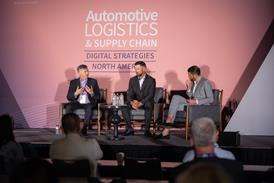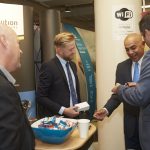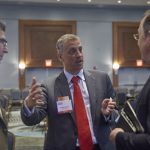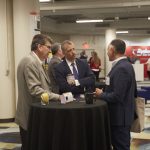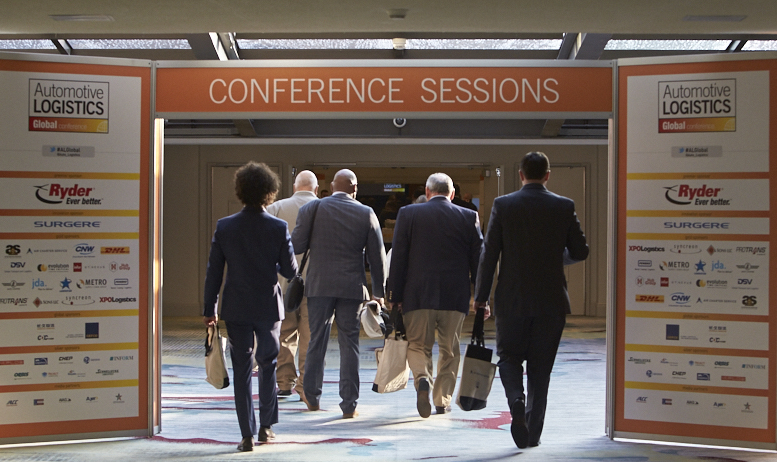 Given the pace of change in digital technology the automotive logistics sector may not know exactly where it will be in ten years but it knows it is going somewhere different and that a risk-to-fail attitude is essential in adopting supply chain strategies for the future. What it cannot risk, however, is not having a new generation of talented disruptors under its wing, as speakers at this year's Automotive Logistics Global conference made clear. Marcus Williams and Gareth Tredway report
Given the pace of change in digital technology the automotive logistics sector may not know exactly where it will be in ten years but it knows it is going somewhere different and that a risk-to-fail attitude is essential in adopting supply chain strategies for the future. What it cannot risk, however, is not having a new generation of talented disruptors under its wing, as speakers at this year's Automotive Logistics Global conference made clear. Marcus Williams and Gareth Tredway report
Much has been said at recent Automotive Logistics conferences about the arrival of the connected vehicle as one of main factors disrupting the supply chain and driving developments in logistics. A lot has also been said about the disruption ahead as consequence of the leap to electrification of the vehicle. According to recent study from PwC, by 2030 34m units of the roughly 80m units that are going to be sold in the US, Europe and China will be hybrid and 44m will be electric. This is huge ramp up from where it is today.What was clear from this year's conference in Detroit, however, was that the industry desperately needed a new generation of talented people to handle the disruption ahead and the developments in logistics. Tech savvy engineers looking for jobs at the Silicon Valley giants needed to be encouraged to see the automotive sector as an attractive proposition in terms of a career because it is they that had the right disruptive mentality to bring about real change.[in_this_story align="right" border="yes"]
Jeffery Estes, group manager for logistics operations and export at Toyota North America, said finding good talent continued to be a challenge, especially among the current generation of 'thinkers and innovators'. He said the carmaker wanted 'disruptors' inside the company and not working externally.
“We struggle to try and market ourselves and be the attractive employer of choice for this next generation,” said Estes. “Those of us who have been in this sector for a long time know it has never been that way, it has always been people knocking on your door saying, 'I want to come work for you'.” That appears to have changed.
![]() Further coverage from Detroit
Further coverage from Detroit
Hurricane effect could keep sales above 17mA stronger Nafta could emerge from negotiations
While Estes saw challenges, attracting young skilled engineers into the automotive supply chain was becoming easier as the digital transformation of the car gathered pace, according to Jack Cooper's president, Andrea Amico. He said there were now multiple pools of talent and what was attracting young engineers was less the money and more the opportunity to work with “fun stuff”.
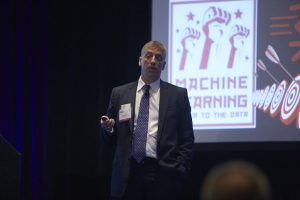
“The ideas they come up with are fantastic,” said Amico in reference to the talent contributing to Jack Cooper's own research and development department. “The next generation is going to be even better. They are highly impatient and very creative. They have disrespect for the rules. We need people who are impatient and want to get stuff done and get it done in different ways.”
Amy Broglin-Peterson, manager of the North American Transport Management Center at Robert Bosch, said the millennial generation brought a natural curiosity that was critical to creating a culture of innovation.
“You have to be constantly challenging the processes that are in place and the technology that exist. The things that made sense ten years ago, maybe don't make sense in today's world,” she said.
In terms of the skills required, Nissan North America's Guillaume Quentin, senior manager, FVL – SCM Strategy/Engineering and Quality Assurance, said the industry needed more long-term strategic thinking that was driven by data analysis.
However, what was also important in securing the people with those skills was the right type of leadership. “I think if we are not freelance innovators and not looking to the future for our customers' needs, our business needs and our talent acquisition, what is going to happen is we are not going to match people to our systems or our process,” Eduardo Huante, general manager on the service parts side at Toyota USA.
Talent and energy required[sta_anchor id="1"]As in previous years, the conference in Detroit featured an automotive logistics students forum and this year executives at the OEMs, suppliers and logistics providers talked about the merits of a career in automotive logistics and the skills for which they were looking. The students present also indicated what they were looking for in terms of a career in logistics. That included stability in a workplace that threw out stimulating challenges and provided variety. According to the students present, they were looking for something that also provided growth and an opportunity to advance and the industries of interest ranged from automotive, through aviation to medical device technology. It was the task of the industry professionals present to convince them the first industry was the one to follow.
 Guillaume Quentin, senior manager, FVL – SCM Strategy/Engineering and Quality Assurance, Nissan North America
Guillaume Quentin, senior manager, FVL – SCM Strategy/Engineering and Quality Assurance, Nissan North AmericaHonda's Dana McBrien, associate chief advisor for North America, who has been in supply chain and purchasing for more than 30 years, said working in automotive logistics meant working in an ever changing environment. “If you are an adrenaline junkie it is a good place to be because you don't know what you are going to see on a daily basis,” he said. That has certainly been the case over recent weeks as networks have been disrupted by storms and earthquakes in the US and Mexico. McBrien said the industry was the best place to be for those who liked change and wanted to drive it but he said that talent needed to be combined with a willingness to work hard.
There was some concern that more traditional carmakers had their own challenges on attracting talent from the newer competitors. Ford's Matthias Schulz, head of material planning and logistics, spoke of the challenge of attracting talent when competing with some of the disruptors from Silicon Valley.
“We are fighting for talent,” he admitted. “If a young engineer has the choice work for Tesla or one of us, I have a suspicion that the choice is being made.”
A clear mission to drive change on a grand scale was the raison d'etre at Tesla, according to Mike Polich, director of global logistics at the company. “Tesla's mission is to accelerate the world's transition to sustainable energy, that is the purpose of our company,” said Polich.
He also said that Tesla's existence was about solving engineering challenges head on, what Polich described as “the stuff that is really hard to do”.
“All the companies [Elon Musk] has been involved in are about taking on engineering challenges,” continued Polich. “Tesla's existence has probably accelerated all of the other companies getting into electric by ten years.”
Polich said the goals he set for his supply chain team were driven by this mission to transform and he handed out hard problems. “I don't think anyone I work with now wants to take a job that is mediocre. They want to strive for awesome,” he said. Likewise, the company was not going for second best when it came to developing systems and supply chains but was “going for perfect”.
Toward that Polich said that logistics is now a target rich environment attracting technological talent in a way that Wall St used to attract the people that were really good at artificial intelligence. Now there was a transition and over the next five years Polich said there would be more transformation in logistics than had been seen in the last 30 years.
 Dana McBrien, associate chief advisor for North America, Honda
Dana McBrien, associate chief advisor for North America, HondaAnother pull factor for working at Tesla according to Polich was that the company was intent on growing quickly to effect its purpose of global energy transition. “We are trying to grow very quickly as a company and while we have no desire in the near term to be profitable we need to be cash-flow positive,” he said. If we are going to impact the environment we need to be much bigger.”
Culturing innovation[sta_anchor id="2"]For innovation to flourish generations old and new needed a new approach to the business according to speakers in Detroit. On the outbound side of the business there is a feeling in some corners that those responsible for vehicle delivery needed to be dragged out of the stone age when it came to innovation and the digitalisation of processes. However, there have been some significant advances. William Wappler, president at CEO at Surgere, the digital supply chain and packaging expert, stated it clearly: “The automotive industry spends more on technology than any other but people think it is slow to adopt. It is really just the opposite, they are spending more and going further than other sectors. They are more demanding.”
Nissan North America's Quentin said that, when looking at the transformation of the vehicle and how it is delivered, organisations need to ensure that the seed of innovation was nourished and that meant a change of mindset. He added it was a case of finding out how to get more agile and adaptable, better aligned, and plan for the digital transformation to the sector that was coming. That included the technology but also recognised the need to attract people with the right attitude and approach.
In its move towards a vision of the future under the Nissan Intelligent Mobility forecasts, the carmaker is looking at three areas where digital technology applies, namely in office functions, yard management and in the delivery of the vehicle to the dealer or end customer.
Revolution in the yard[sta_anchor id="3"]Yard management, to take one of them, is a focus area for the application of digital technology and many carmakers rely on their service providers to come up with the goods.
Robert DeCrick, head of vehicle logistics at FCA said the company relied on its service providers and port processors to manage the yard with their technology but he acknowledged that over time autonomous and connected vehicles would offer the potential to make that more efficient than they are now.
Honda's Chuck Kendig agreed and said that while it still used paperwork at yard gates it was looking at a range of options for a paperless method that would in time remove the need to stop and scan.
Within the yard, Nissan has been exploring locating vehicles, automating yard exits and removing the need for manual scanning and paper transactions, according to Quentin. This is where RFID and potentially telematics come in and the company has been involved in a project that involves integration through the supply chain to the extent that it engages design and manufacturing of the vehicle.
In terms of delivery, Nissan is looking at how to secure ETAs and notification of when vehicles are being delivered. Quentin said it was important to look at using geofence capability and connectivity.
Yards are also a great place to test innovation in autonomous vehicles according to Jack Cooper's Andrea Amico and this is where the service providers, to whom the carmakers look for support, can play a bigger part in the revolution going on in the automotive world.
“We have two unique advantages,” said Amico. “One is that the car has never been touched by anybody and our yards are a controlled environment. It is a simple operating domain but you have people and cars, and you've got equipment and weather conditions. That is a great place for OEMs to go and put a lot of hours into their autonomous cars and test them in a controlled environment to make them safer and smarter. I think we can play a unique role in this revolution.”
Accelerating security[sta_anchor id="4"]As with all advances in technology, a digital supply chain used to move increasingly sophisticated digital cars brings with it a new set of problems. Chief among them is cybersecurity, something that has become a major concern over the last couple of years with a growing litany of failures and hacking scandals. At the beginning of September it was revealed that there had been a massive security breach at Equifax credit bureau affecting 153m customers. “That smoked $5bn in equity in a day and two hours after the breach a $60bn class action suit was filed against the company,” noted Andrea Amico. “That is the sort of thing that destroys companies.”
The Wannacry ransomware attack that hit MOL and TNT Express also closed Honda's Sayama Plant in Japan, which has a daily output of 1,000 vehicles and disrupted Renault-Nissan plants in France and Slovenia. In terms of the car itself, three years ago FCA had its own problems when Wired magazine cooperated with two hackers that showed how easy it was to remotely take control of a Jeep Cherokee while it was in transit. According to Amico that cost the carmaker $400m in lost equity and the recall of 1.4m vehicles.
Amico pointed to a recent IBM white paper – Accelerating security: winning the race to vehicle integrity and data privacy – that said vehicle security is as important as safety.
The paper outlines priorities for the automotive industry. One is that OEMs need to design security into the vehicle, which is a considerable task when you understand that the modern car has a 100m lines of code, compared to the whole of Facebook for instance, which runs on 60m lines.
“A car is way more complex than just about everything,” he said.
 Brandon Mason, automotive director and mobility leader, PwC
Brandon Mason, automotive director and mobility leader, PwCThe IBM report says OEMs and suppliers need to build a trusted supply chain so it can be certain that the parts have not been hacked before they are built into the vehicle. The production line also needs to be secure and there is a whole section on creating trust in the distribution channels.
“We should not ask what the benefits are of the autonomous vehicles to the industry, we need to ask what we can do to make the connected vehicle safer, more autonomous and how it can create value, because that is what creates partnerships,” said Amico. “If we don't it will be a horrible scenario that I hope we are not part of.”
Luckily there are associations out there looking at the problem, such as the Automotive Information Sharing and Analysis Center (Auto ISAC), a global automotive industry collaboration of light- and heavy-duty vehicle OEMs and suppliers (including the commercial vehicle sector) focused on cybersecurity.
Blockchain protection[sta_anchor id="5"]Another emerging area of interest that has potential for benefiting cybersecurity is the blockchain, the Bitcoin supporting system that allows digital information to be distributed but not copied. Or, to quote more accurately from Don and Alex Tapscott, authors of Blockchain Revolution “an incorruptible digital ledger of economic transactions that can be programmed to record not just financial transactions but virtually everything of value.”
According to PwC's automotive director and mobility leader, Brandon Mason, the technology has the potential to advance security.
“The thing about blockchain is that while it was originally designed for monetary transactions what they have found is that there are all sorts of possibilities as it relates to cybersecurity,” he said. “There are not endless possibilities but if you think about the high priority that is going on in cybersecurity, especially in the last couple of weeks, blockchain has applications to any area, including automotive logistics.”
Blockchain technology is being taken up by a variety of sectors, including automotive, and Kevin Hogan at analyst Ernst and Young said it represents capabilities that simply didn't exist before. However, he also said that it still needs adoption in the automotive supply chain. Citing examples where blockchain technology had helped in dealing with fleet transactions Hogan said that the industry was on the verge of figuring out how to exploit the opportunities that it offered in the logistics space. That included in gaining visibility for long distance shipments on a part level.
“I think that is the kind of example where you have multiple parties who all have a slightly different interest and you need a single source to the truth; there is a transaction value to this,” said Hogan.
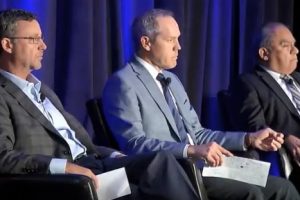 Ryder's Gary Allen, Kevin Hogan, Ernst & Young, and Rogelio Landin from the US-Mexico Chamber of Commerce
Ryder's Gary Allen, Kevin Hogan, Ernst & Young, and Rogelio Landin from the US-Mexico Chamber of CommerceInform's Ruud Vossebeld said there were potential applications of blockchain technology for trustworthy and more transparent vehicle transactions with and between dealers on the retail side of the business. Using the technology to provide greater visibility in finished vehicle sector is something Inform is exploring.
“From a car transporter point of view, for example, there is trading between dealers with cars and many times the dealers don't know each other that well but you could use blockchain to connect the dealers and make sure the payments are done correctly. It gives them the trust level and they get some guarantee that the payment is made.”
Visibility and trust become even more of an issue when trade is between different countries, between the US and China for example. “You are sure the dealer will make the payment when transport is made to the US and trade then could accelerate because trust issues are dealt with and there is a way to track the process with a blockchain platform.”
Adapting to the Amazon experience[sta_anchor id="6"]Innovations in the supply chain increasingly have as their priority customer satisfaction but expectations have changed dramatically in recent years under the influence of companies such as Amazon and Uber. Adapting to this demand for faster delivery and greater visibility is one of the biggest challenges for the automotive sector at the moment.
Omer Rashid, senior director of solutions design at DHL, pointed to the e-commerce sector in North America as an example of how the retail sector was being reborn and what it meant for automotive services.
In North America, e-commerce continues to grow at double digit rates, something enabled by the latest digital technology, a trend that is going to continue, according to Rashid. The e-commerce sector is forecast to surpass $350bn in North America this year and gains 1% market penetration a year. Amazon itself has 15% of the market and stores are continuing to close at a rapid pace, though this is not this is not the death of retail but its rebirth, and Rashid said all sectors were now looking at how to respond and change their networks to meet the changing demands of the customer, automotive included.
There are clear trends that are going to disrupt the automotive industry. Carvana, the online only car dealer and technology company, has a pitch to the customer that states “buy used cars online and skip the dealer”. The company can have a vehicle delivered to the customer's door for a trial if they live within 100 miles of the service location.
“Customers now expect cheap, fast and good service without having to pay the premiums,” said Rashid, adding that that required an efficient fulfilment and delivery model, utilising advanced analytics.
“The technologies that they have talked about for years are coming into play,” said Rashid, “and leading brands will continue to develop the strategy to get close to their customers.”
On the inbound side Ford's Matthias Schulz said that over time the powerful logistics networks owned by e-commerce giants could even be used to deliver parts inbound to the carmakers.
“I am absolutely convinced that 10 years down the road Amazon will deliver production parts to Ford,” he said. “There is no reason to believe why it wouldn't work because all the modern technology and the visibility on the web is so high.”
On the outbound side FCA's DeCrick said that variability on transit times between factory and dealer could be frustrating because the technology was there and FCA tracked things quite closely.
“It is a question of what you give the customer as an ETA,” he said. “If you set their expectations too aggressively then they will get ticked off if you are a few days late, or you could get conservative and go the other extreme. Addressing variability is always going to be a challenge and it depends if it is a retail customer or a dealer because they sometimes have different expectations.”
However, he also emphasised that getting the customer a car in good quality on time was the priority and that giving the customer too much information could eventually be irritating. There was also the fact that many buy from existing stock.
Chuck Kendig said there was probably more Honda could do to become more customer focused in the era of Amazon and other similar services. He said the company focused on quality and timeliness, and currently hit an 80-85% on-time delivery target despite all of the potential problems in the outbound supply chain. However, the perceived failure to provide more accurate visibility on the delivery status of the car was becoming an issue.
“[Dealers say] 'why is it that I can order something on Amazon, or a pizza, and can see exactly where that is, but with a $50,000 car I get a three-day window', Kendig related. “That is a big discrepancy between the person's experience at home and what we provide. We need to much more customer focused.”
 Omer Rashid, senior director of solutions design at DHL
Omer Rashid, senior director of solutions design at DHLHowever, Kendig said it all came down to a return on investment (ROI) and providing an Uber like experience for the customer cannot cost more than $100,000 because above that there is no return.
“There is certainly a great soft side to it but ultimately to buy a system like that we have to be very smart and nimble. To put a lot of expense into that [system] is going to end up at the sticker price and there is huge downward pressure on pricing, especially as we go to electrification and those being less profitable vehicles.
Subaru currently provides delivery dates in two ways: one date is given when the vehicle is scheduled, which could be a week, or between 15-20 days, depending on location according to Gerald Lee, vice-president of vehicle planning and logistics at the carmaker. A second ETA is given as an update at each stage of the delivery process. That date can jump around, said Lee, sometimes to the frustration of the dealer, but they always have the original date to which to refer.
“For our sold order customers we have started to communicate with both the dealer and the customer, and that was a little tricky because dealers don't like the manufacturer communicating directly with the customer,” said Lee. “But we have had virtually no blow back since we started that. The customer is calling the dealership so they may be a little relieved that we are taking some of that from them and providing a status.”
Sharing the resources[sta_anchor id="7"]On the question of Amazon and Uber models Surgere's William Wappler said finished vehicle logistics services would always be compared to other models but he asked about the application of shared resource modelling in the sector, citing examples taken up by FedEx and UPS.
“They don't look at independent companies anymore. During Christmas UPS uses the post office, they all come together and use all the independent resources as a single entity,” explained Wappler, and he asked the carmakers whether it was something they were looking at.
Honda's Kendig said it was the next big efficiency gain for the sector and something that Honda was already talking about.
“Instead of us competing and asking different providers [across the modes] to come up with special schedules for us, why don't we combine resources?” asked Kendig. “We are all going to the top 20 markets in the US generally [and] it is something we are beginning to think about; I think that is the next big efficiency.”
He went on to say it was especially important in Mexico, where Honda was trying to get the frequency of ship calls and quick rides out of the country to avoid vandalism.
Gerald Lee at Subaru said the if the company was doing a good job of scheduling it should be making good shippable loads at the rail heads so the trucks were full of Subarus but he said they were already free to co-load if they needed to. “I want the truckers need to be profitable so I don't expect them to make a milkrun to eight or nine dealers,” he added.
FCA's DeCrick pointed to the fact that carmakers were already using a shared asset network. “We use the same haulaway carriers as a lot of the other OEMs. Some rail providers also co-load in some cases,” noted DeCrick, adding that the carmaker already did a fairly good job of utilising joint assets rather than having its own pools of carriers. However, he noted that there were challenges.
“We have tried with other OEMs to look for opportunities to make up empty miles and so forth with some success but it is difficult to align everyone's interests and make it a win win,” he said. “It is something we will continue to do.”
From a tier-one supplier logistics standpoint, Patrick Bauer vice-president of logistics and supply chain at Faurecia, suggested more transport sharing partnerships could be formed between the tier ones.
“We don’t do a very good job as a tier-one community, with our LSPs, to actually share the transportation network,” he said.
Bauer added that sharing the network could enable suppliers to better manage the changes in demand, the volumes, mix and whatever else was going on with their customers by working with each other to ensure transport is being fully utilised.
“If you look at our manufacturing and supply base footprints I can almost guarantee they lay on top of each other, so there is this tremendous opportunity, if we are willing to do it, to share transportation,” he said.
Adam Pieniazek, senior manager for logistics in North America at Magna Powertrain, also saw scope for sharing logistics networks but he said that commonality was key, including in packaging, standardisation of truck sizes and systems that were flexible enough to be able to integrate with others.
“In some of our situations we use a 3PL and where there are other people that use a 3PL we could start sharing the network with respect to transportation,” he said.
 William Wappler, president and CEO of Surgere
William Wappler, president and CEO of SurgereExtended disruption[sta_anchor id="8"]Surgere's William Wappler said the automotive sector needed to get used to the concept of “extended disruption”. Based on early data that his company has collected on the impact of Industry 4.0 on visibility and control in a digitalised supply chain, Wappler said performance improvements on average have incrementally adjusted upward to around 13.8% .
“Cost savings are expected to be 22.4% with a digitalised supply chain,” added Wappler, and importantly that affected everyone involved in the supply chain. The savings made to inventory loss by packaging suppliers, for instance, will be felt by the companies supplying them with plastic materials and tooling.
“Extended disruption is happening and we are not all preparing for it,” said Wappler. “We have to innovate and invest, and review our business models.”
Lars Otte, vice-president of business development at Schnellecke Logistics, said that the only way to measure disruptive innovation was to put into serial production rather than it being restricted to constant pilot projects. Taking risks that might fail was essential to the process, according to Otte, and it promoted awareness and acceptance amongst employees that the technology now becoming available was important.
Schnellecke is working with Volkswagen Group of America (VWoA) at its plant in Chattanooga and together the companies are now looking at the transformations to logistics that the arrival of the electric vehicle will herald. According to Otte, there are 80 new electric vehicle models expected by 2030 and that no only means an impact on the inbound logistics supporting this model variance, it actually means the variance in part number will actually drop. Otte said the part numbers used in the engine, for instance, would drop by around 1,000. There are between 200-250 parts in an electric vehicle engine compared to between 1,200 and 2,400 in a combustion engine. The manpower required to build an electric vehicle would also be seven times lower what it is to build a conventional vehicle.
There is some question over how fast this transformation to electric will be, at least based on US domestic demand for the electric vehicle. According to PwC's alternative fuel outlook there is every possibility that standards for adopting cleaner vehicles will be rolled back in the US. Lower oil prices there and the choice of bigger trucks indicate the market is moving in the opposite direction to those in Europe and Asia, which are leading in the adoption of alternative powered vehicles, driven by regulatory measures.
“The one market that is contrary to rest of the world is the one we are sitting in today,” said PwC's Brandon Mason. “Not only are we talking about freezing or a pause in fuel efficiency standards but there is a possibility of rolling back standards. In the absence of a strong regulatory environment the US will probably lag the rest of the world as it relates to market share in alternative propulsion vehicles. As it stands it is only about 3% in the US.”
Nevertheless, in preparing for the change to electrification, in 2016 VW established its Transform 2025 strategy and a lot of that strategy focuses on significant improvements in efficiency and productivity. At the same time VW is making massive investments in connectivity.
“At the factory level we have a huge emphasis on preparing for the future,” said Amanda Lovin, manager of in-house logistics, VWoA. “We are making the factory and the people ready, with a focus on productivity and innovation.”
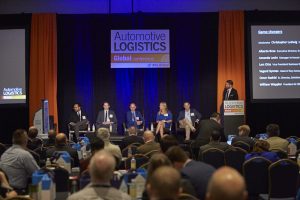 OEMs, supplier and LSP representatives discussed the game changers for the automotive sector in session five
OEMs, supplier and LSP representatives discussed the game changers for the automotive sector in session fiveSpecifically for logistics, Lovin said the carmaker was looking at innovative solutions based on digitalisation and automation. She stressed VW was also looking at supply chain optimisation with its logistics partners and addressing what was preventing the rapid change needed to move forward.
VW has 300 different systems and interfaces in Chattanooga in the supply chain alone, said Lovin. Digitalisation had the potential to change this and the company had to realign resources and technical expertise. Lovin admitted that the supply chain may not be it is core area of expertise or a priority area for investment, which was why it was looking for partnerships with logistics service providers.
“Logistics service providers, including the innovative technical companies, can help us increase innovative expertise,” she said. “They can give us new technology and help us to align our data and run it in more effectively.”
Investing for the future[sta_anchor id="9"]The automotive sector doesn't know exactly where it is going with all the technologically driven changes happening today but it knows it is going somewhere different. According to Brandon Mason it was important to keep in mind that immediate investment was needed in the latest technology regardless of the return. The trends and technology seen today will be the drivers of tomorrow according to Mason and while they could change wildly that was what was exciting about the industry right now. Being able to adapt to it was crucial for survival and a big part of that was a willingness to collaborate. “It cannot be stressed enough that strategic partnerships are an absolute must, whether with a competitor or supplier, or another third party,” said Mason. “You need to work together to share knowledge and resources will be the only way to adapt to the changes.”
What was also clear from this year's Automotive Logistics Global conference was that the automotive industry recognises the need for change both in terms of the products it makes, and how it makes them, but also in terms of the way it uses the technology and talent at its disposal to move those products more efficiently to market. To do this it needs to step back from its daily operational focus on the way things are done and look for opportunities for radical changes in the way it manages both the inbound movement of parts and the delivery of vehicles to the customer, whether that includes a dealer or not. It also needs to free up the resources to make the changes necessary to deal with the complete transformation of the industry that the digitalisation is bringing.
Automotive Logistics Global is part of the global Automotive Logistics series of conferences.
The next conference in the series is Automotive Logistics UK summit, which will take place at The Grove in Hertfordshire between 3-4 October this year
Topics
- Analysis
- Digitalisation
- electric vehicles
- Electric Vehicles
- features
- Fedex
- Finished Vehicle Logistics
- finished vehicle logistics
- government and regulation
- Inbound
- Inbound Logistics
- Inventory management
- Nissan
- North America
- OEMs
- OEMs
- Packaging
- Plant Logistics
- Policy and regulation
- Road
- Ryder
- Suppliers
- supply chain management
- Supply Chain Planning
- Telematics
- Tier suppliers
- Track-and-trace
- UPS



























